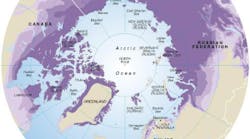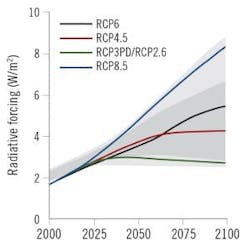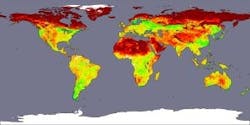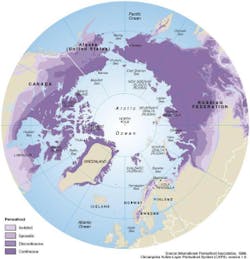Figure 1: United Nation Intergovernmental Panel on Climate Change (IPCC) projections of radiative forcing of representative concentration pathways (RCP) for four scenarios, from RPC 2.6 (emissions peaking in 2020, resulting in a maximum concentration of 440 ppmv in 2080) to RPC 8.5 (emissions peaking in 2100 resulting in a maximum concentration of 950 ppmv in 2100 and rising). Source.
If we compare global warming control (GWC) with industrial processes, the big difference is that there, the "manipulated variable" and the "setpoint" are different (i.e., we set a temperature and control it by throttling steam). In case of the GWC, they are the same. Mankind "throttles" its own behavior.
The United Nation's Intergovernmental Panel on Climate Change (IPCC) provided some setpoints using the units of radiative forcing (RF), which expresses the energy imbalance of the planet in watts per square meter, causing the warming (Figure 1). They set this "setpoint" only as a voluntary target, recommending that the difference between the solar heat input and the heat loss back into space should be limited to one that doesn’t cause more than a 1.5 °C peak in warming.
I find such voluntary targets, treaties and agreements rather useless, so I won’t spend time discussing them. Instead, I will turn to the facts that we can calculate to quantify the "personality" of this GW process, and after that, I will describe the recommended control algorithm and manipulated variable to bring the GW process under control.
Time constant: Temperature rise curves show that the time constant of this process is about 20 years. In other words, if a change occurs in the heat balance (climate forcing W/m2 changes) of the planet, it takes about 20 years to reach 63% of its full effect and thereby reach a new steady state. We have also seen that GW is a nonlinear heat-balance process having tremendous capacities and inertias, plus some unpredictable tipping points, and that it is totally out of control.
Tipping points: In process control, we deal with continuous processes, batch processes or with processes that change their "characteristics" at certain tipping points. Global warming is one of these. In case of this heat balance process, a tipping point occurs, when the solar heat balance suddenly changes. If GW is left uncontrolled, at least two tipping points will be reached. One has to do with "the albedo effect," the other with the melting of the ice at the poles and is the glaciers.
Process gain: The gain of this process is the ratio of the total change in the global temperature and the change in CO2 concentration that caused it. During the past 60 years, we have measured that a rise of about 60 ppmv CO2 concentration in the atmosphere (from 350 to 410 ppmv) caused a 0.9 °C rise in global temperature. So, the gain (rate of rise) averaged about 1.5 °C for each 100 ppmv rise in CO2 concentration. In terms of speed, the gain was about 0.15 °C per decade. (Based on the more recent reports, the gain has increased to 0.2 °C per decade, and is still rising.)
Figure 2: NASA Earth Observatory shows the areas that are today reflecting (brown near the Arctic), but could top doing it due to melting. Source.
Error accumulation (integral): During the industrial age, about 400 gigatons of extra carbon accumulated in the air and it’s still rising due to our present emissions. The yearly carbon emission today is 9-10 billion tons and is still rising. In other words, the per-capita daily carbon emission is 8 lb. (23 lb. of CO2). This also means that even if we reach a carbon-neutral lifestyle and cut our carbon emissions to zero, the accumulated carbon that remains for many decades will continue to increase the global temperature, only at a slower rate.
Albedo tipping point: The albedo number represents the fraction of incident solar energy that is reflected by a surface back into space. A typical ocean albedo is approximately 0.06 (or 6%), while bare sea ice albedo varies from 0.5 to 0.7 (https://nsidc.org/cryosphere/seaice/processes/albedo.html). The albedo effect is the process that occurs when the highly reflective polar and glacier ice melts, and is replaced by radiation-absorbing water or permafrost. When this occurs, the heat input of the planet rises (radiative forcing rises) and this feedback cycle accelerates because the increase in forcing increases temperature, which further increases melting, resulting in even more carbon release. To my knowledge, the effect of this self-intensifying process is not considered in the UN's RCP scenarios. If I am correct, this is a major omission. It seems to me that this effect is already working—the Arctic is warming much faster than the rest of the planet (compared to the global average of 0.9 °C, this summer it was over 10 °C). This albedo effect will continue as long as there is ice on the planet and for that reason, our global warming projection models must consider it (Figure 2).
Permafrost melting (positive feedback): As the ice on land reflecting solar radiation melts, in addition to the albedo effect, ice is replaced by radiation-absorbing permafrost, which releases immense amounts of CO2 as it melts. This further increases the greenhouse effect and therefore, further accelerates the melting. This cycle accelerates, and because twice as much carbon is stored in permafrost as the total carbon in the atmosphere, this can have a great impact on global warming. In process control, such self-intensifying processes are always modeled for at least a period of five dead-times (in this case, a hundred years). So, all our global warming models must be based on projecting into the future for at least until the end of this century. Similar to the albedo effect, this permafrost effect also triggers a tipping point, it has already started and will continue many decades, and all GW models should include it, including the UN RPCs (Figure 3).
Figure 3: Permafrost covers 25% of the Northern Hemisphere's land area and contains some 1,500 billion tons of carbon, according to the National Snow and Ice Data Center. Source.
Temperature distribution and ice melting: Talking about global warming in terms of global average temperature rise is not very meaningful, because it’s the local temperatures that determine local conditions. Today, the global temperature rise on land is about 2.0 °C (3.6 °F) and on the oceans, about 0.5 °C (0.9 °F), while in the Arctic it is 10 °C (18 °F) or even more in the summer, partly caused by the albedo and permafrost effects. These temperatures matter more than the global average because they cause the forest fires, water shortages and agricultural losses in the already dry regions, and excess rain and hurricanes in the already wet regions, etc.
An example of local warming effects is the melting on Greenland, where the cold ice melts and flows into the Atlantic, which locally cools the ocean. In addition, the melting causes a rise in the sea level. This rise today is insignificant, probably not more than a meter by the end of this century, but this could change if the temperature in the Arctic further increases. If all the ice on Greenland ever melted, (2.5 million km3), the ocean levels could rise by some 7.2 m or 24 ft (https://en.wikipedia.org/wiki/Greenland_ice_sheet; www.worldwildlife.org/pages/why-are-glaciers-and-sea-ice-melting). Also, the ice on the Antarctic is 10 times that on Greenland, but I’m sure we’ll never get to the point where we allow them to melt—they are the air conditioners of the planet.
During the past two decades, a number of international meetings were held but all they resulted in were some desired limits on the allowable temperature rise (based on little more than wishful thinking). When looking at this uncontrolled process, for a process control engineer, the task is obvious: We must close the GWC loop, we must add a manipulated variable and throttle it! And what is the only variable that can change human behavior? It’s money. So, whether it is through taxation, subsidies or education, we must close this loop.









